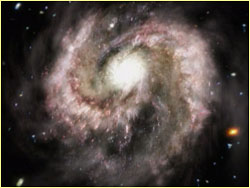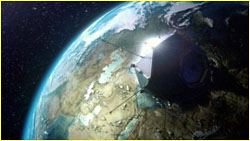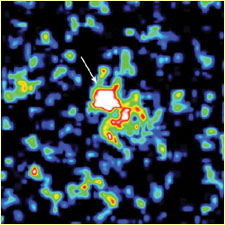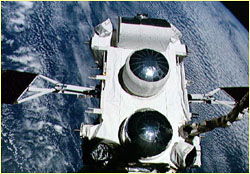 |
 |
|
|
 What would happen to us if a gamma-ray burst
occurred nearby in our own galaxy? Read on—if you dare.
What would happen to us if a gamma-ray burst
occurred nearby in our own galaxy? Read on—if you dare.
|
A Bad Day in the Milky Way
by Jerry Bonnell
For me, one of the compelling ironies borne of discoveries in astronomy over
the past few decades is the contrast between the detection of planets outside
our solar system, which has fueled speculations about life beyond Earth, and
the discovery of perhaps the most violent, inhospitable events in the universe—gamma-ray bursts—which have fueled speculation about a conceivable end to
life on Earth.
Unlike the detection of extrasolar planets, for which astronomers were actively
searching, the discovery of gamma-ray bursts—sudden unpredictable flashes of
high-energy photons coming from space—was serendipitous. In the 1960s, the
U.S. Air Force launched a series of satellites designed to verify the
conditions of the Nuclear Test Ban Treaty, whose signatories, including the
United States, Britain, and the Soviet Union, agreed not to test nuclear
devices in the atmosphere or in space. Called Vela, from the Spanish verb
velar ("to watch"), the satellites bore experimental detectors intended
to give the U.S. a means to monitor nuclear bomb tests. In a 1973 publication,
Ray Klebesadel, Ian Strong, and Roy Olson of the Los Alamos Scientific
Laboratory announced that Vela gamma-ray detectors had indeed picked up
high-energy gamma-ray flashes—but they originated not from Earth but from deep space.
 Busily scanning
Earth for gamma rays from nuclear explosions, Vela satellites inadvertently
discovered the most violent celestial explosions since the Big
Bang.
Busily scanning
Earth for gamma rays from nuclear explosions, Vela satellites inadvertently
discovered the most violent celestial explosions since the Big
Bang.
|
|
Gamma-ray bursts may sound exotic, but they are actually quite common. During
the 1990s, the so-called Burst And Transient Source Experiment (BATSE), an
instrument aboard NASA's orbiting Compton Gamma Ray Observatory, found that
bursts lasting from fractions of a second to tens or hundreds of seconds
occurred roughly once a day. In orbit in 1991, nearly 30 years after the first
Velas, BATSE ("battsy") was the most sensitive detector of cosmic gamma-ray
bursts ever constructed. But even BATSE could only watch the gamma-ray
emissions from the bursters fade away, never to be seen again and leaving no
clearly identifiable trace of their sources. Nevertheless, BATSE could
determine the general direction in which each of the gamma-ray bursts occurred.
Early BATSE maps of locations of gamma-ray bursters showed that bursts came not
only at random times but from random directions.
Striking fear
The BATSE results struck fear into the hearts of astrophysicists around the
planet. Well, maybe not fear, but some did seem to experience symptoms of
"ergophobia" (fear of energy). The concerns arose after it was realized that a
startling but natural explanation of the bursters' random positions and
observed brightness was that they were located in distant galaxies, themselves
randomly distributed in our sky. Now, to be in galaxies far, far away and yet
detectable on Earth, the burst sources, whatever they are, had to release truly
enormous energies—tremendous but distant explosions only faintly "heard."
Instead of a nuclear bomb-sized hiccough from a nearby neutron star, such truly
cosmological distances (i.e., in the billions of light-years) to the bursters
seemed to require the sudden conversion of a significant fraction of a star
with the mass of the sun into gamma rays a la Einstein's famous equation
E=mc2. The idea of such extreme energies led many to search for
other explanations of the BATSE results.
|
 An
X-ray afterglow image of a gamma-ray burst that occurred on February 28, 1997,
taken by BeppoSAX.
An
X-ray afterglow image of a gamma-ray burst that occurred on February 28, 1997,
taken by BeppoSAX.
|
The cosmological distance scale to at least some of the burst sources is now
firmly established, though. The observational breakthrough came in 1997 when
BeppoSAX, an Italian/Dutch X-ray astronomy satellite, was able to identify
X-ray afterglows of gamma-ray bursts. The fading afterglows were visible long after the gamma-ray burst
emission had disappeared, and BeppoSAX located them well enough to permit
follow-on observations with large, ground-based optical telescopes. The burst
sources were clearly seen to lie in galaxies billions of light-years distant,
confirming the enormous energies produced.
In addition to fading afterglows, prompt optical emission was actually detected
while a gamma-ray burst was in progress in 1999. This first-ever visible light
image of an ongoing gamma-ray burst was recorded by the automated Robotic
Optical Transient Search Experiment (ROTSE-I) operating at Los Alamos, home of
the original satellite-borne cosmic gamma-ray detectors. Impressively, if that
burst had occurred in our own galaxy at a distance of about 3,000 light-years,
the direct optical emission would momentarily have appeared to us at least as
bright as the noonday sun. [To hear what it was like to discover the first
optical counterpart of a gamma-ray burst, see One Astronomer's Universe.]
 In this
NASA photograph, the Compton Gamma Ray Observatory—host of BATSE and other
sophisticated instruments—floats above Earth.
In this
NASA photograph, the Compton Gamma Ray Observatory—host of BATSE and other
sophisticated instruments—floats above Earth.
|
|
Bursting Earth
In the early 1990s, however, astrophysicists hotly debated the significance of
the BATSE results, including the implied distances and energies. This debate
led to thoughts of what would happen if a burst occurred in our galactic
neighborhood.
Wondering if any other lines of evidence might point toward such extreme
postulated energies for gamma-ray bursts, for instance, Princeton University's
Steve Thorsett, writing in the May 1995 Astrophysical Journal Letters,
calculated some terrestrial consequences that might be expected if gamma-ray
bursts really were at cosmological distances. He asked, what if such a burst
occurred somewhere within our own galaxy, say only thousands of light-years
away? Building on past researchers' descriptions of the consequences of a
nearby supernova or exploding star, Thorsett outlined in general terms a
disheartening scenario of a local gamma-ray burster firing its energetic
photons at planet Earth.
Regardless of the mechanism producing the burst, the intense flux of gamma rays
would likely be stopped in the lower stratosphere by collisions with
atmospheric nitrogen molecules. The molecules would break up and reform as
nitric oxide and related compounds. (Hanging over cities today, nitric oxides
are the brownish constituents of smog; they are also catalysts for the
destruction of ozone.) Uncheerful brown skies and stratospheric ozone
destruction would initially affect only the hemisphere facing the gamma-ray
burst, but winds would soon spread the destruction worldwide.
Continue: How much ozone would be destroyed?
Photo credits
One Astronomer's Universe |
A Bad Day in the Milky Way
Catalogue of the Cosmos |
Tour the Spectrum
Resources |
Transcript |
Site Map |
Death Star Home
Search |
Site Map |
Previously Featured |
Schedule |
Feedback |
Teachers |
Shop
Join Us/E-Mail |
About NOVA |
Editor's Picks |
Watch NOVAs online |
To print
PBS Online |
NOVA Online |
WGBH
© | Updated January 2002
|
|
|
|